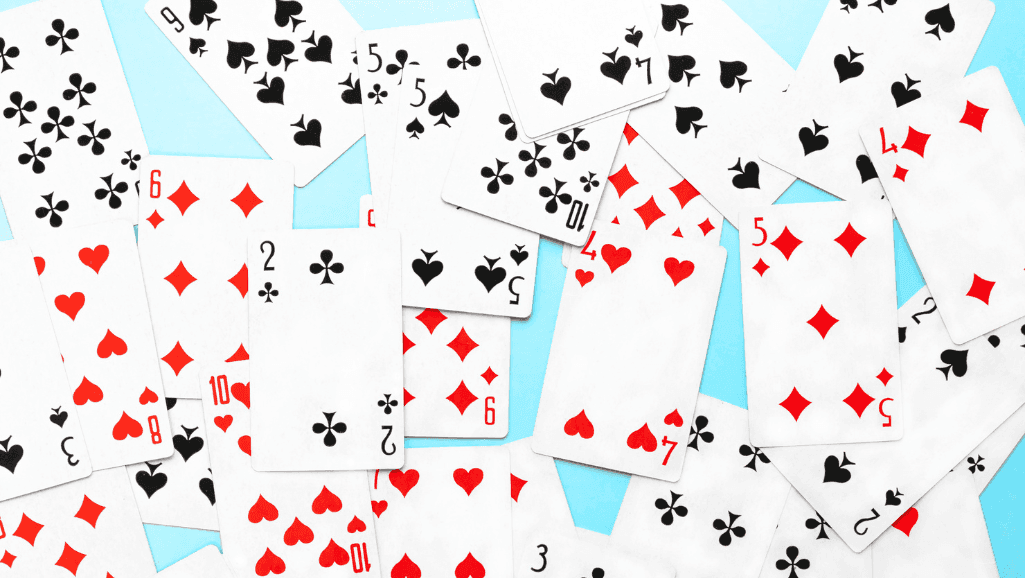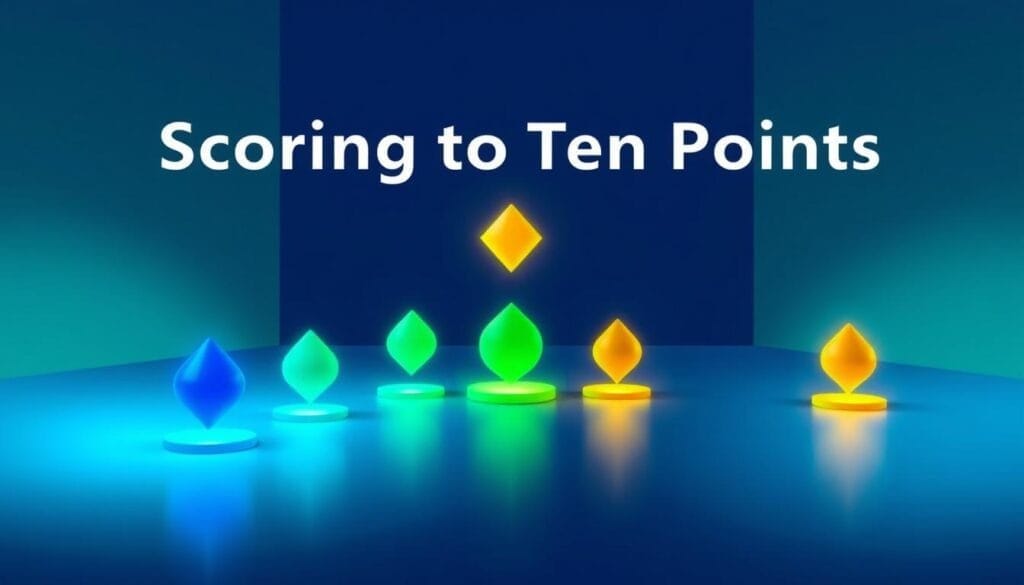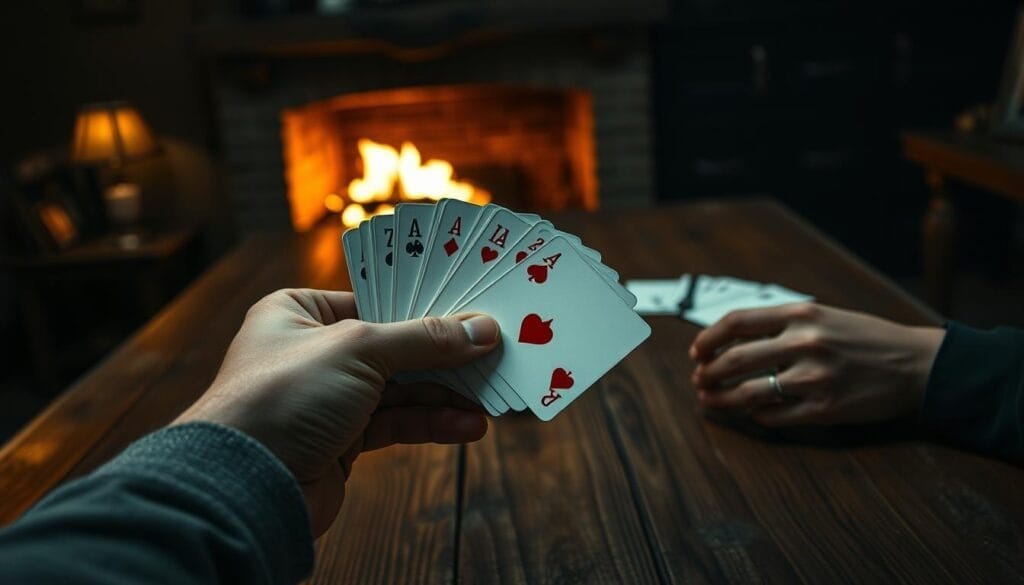Euchre is a brisk, social trick-taking card game perfect for casual nights or friendly tournaments. Four players sit as two teams of two and play with a compact 24-card deck (9 through Ace). The objective is simple: race to ten points by winning the majority of five tricks each hand.
Naming trump reshapes every card suit and hands control to the team that calls it. The player who names trump becomes a Maker; Makers must win at least three tricks out of five while the opposing team defends. Special rules elevate the Jacks — the Right Bower (the Jack of the trump suit) and the Left Bower (the Jack of the same color) — into the top trump cards, so spotting those Jacks can turn an otherwise weak hand into a winning one.
Play moves fast: the player to the dealer’s left leads first, winners of each trick lead the next, and scoring is straightforward — Makers earn 1 point for taking three or four tricks, 2 points for a five-trick sweep (a march), and additional points or penalties apply for going alone or being euchred. With clear tempo, attention to suit led, and teamwork, most players feel comfortable after a few rounds.
Key Takeaways
- How to play euchre card game: four players, two teams, and quick five-trick hands.
- Use a 24-card deck (9–A in each suit) for brisk, tactical rounds.
- The first team to ten points wins — every hand matters.
- Naming trump changes the highest card suit and strategic choices.
- Right and Left Bowers (special Jacks) are the highest trump cards.
- The winner of each trick leads the next, so tempo and position matter.
- Going alone can yield big rewards but carries clear risk.
What Is Euchre? A Quick Overview for New Players
This classic trick-taking pastime gives four players tight, tactical rounds around the table. Euchre is a fast-paced card game played in partnerships. Each hand contains five tricks and rewards clear choices, counting, and teamwork.
Setup and flow: Deal five cards to each player and turn one card face up. Players then decide whether that suit becomes trump or the option is passed. The team that names trump are the Makers; Makers must take at least three tricks to score. The opposing team — the Defenders — try to stop them. Play proceeds clockwise, and the winner of each trick leads the next, so each trick reshapes the round.
- Think of euchre as a brisk five-trick race of momentum and timing for every player at the table.
- With only 24 cards, each card played gives quick, useful clues about who holds which suits.
- Order up, pass, or go alone—these pre-play choices set the stakes before the first lead.
- The first team to reach ten points wins the match, so every round matters.
Deck, Setup, and Table Basics
A crisp, 24-card pack and clear scoring make each round fast and fair. Build the euchre deck by removing cards 2–8 from a standard 52-card set so you keep 9, 10, J, Q, K, A in each suit. This short deck creates tight, tactical play where every card matters.
Scoring is simple and visual. Many groups use two physical 5s per team as an easy tally: slide or flip pips after each hand so points remain obvious at the table. If you prefer digital tracking, a notepad or phone app works equally well—just agree on the method before play begins.
Seat partners opposite one another so turns rotate evenly and play stays smooth. Keep a clear center area for the remaining deck, the turn-up card, and neat trick piles so everyone can follow progress and count cards when needed.
- Create a compact deck of 24 cards for brisk hands and clearer card-counting.
- Use physical scoring fives or a simple digital tally—consistency keeps the table moving.
- Agree on house rules (dealing style, stick-the-dealer, jokers) before the first deal and shuffle thoroughly for balanced deals.
Teams, Seating, and Choosing the Dealer
Organized seating and a predictable dealer cycle set the stage for each brisk round. Four players form two teams and sit opposite each other so partners are across the table, creating clean turn order and steady partnerships.
Starting player, dealer rotation, and around-the-table flow
Pick the first dealer quickly by drawing high card; resolve ties with a redraw. After the opening deal, the dealer role moves clockwise (to the dealer’s left) each hand so everyone shares duties evenly.
The starting player for each hand is the person left of the dealer; that player leads the first trick and helps set the tempo for that round.
“Clear seats and steady rotation let a table move fast and stay fair.”
- Form two teams of two and sit opposite for predictable turn order around the table.
- Keep the deck and turn-up card visible in the center so choices about ordering up or passing are informed.
- Confirm verbal calls (e.g., “pass,” “order it up,” “alone”) before action begins to avoid confusion mid-hand.
Dealing in Euchre: Hands, Turn-Up Card, and Order of Play
A brisk, orderly deal sets the tempo for every round at the table. The dealer shuffles, then deals five cards to each player in two packets—commonly 2 then 3 or 3 then 2—always moving clockwise (to the dealer’s left) and beginning with the player on the dealer’s left.
After the deal, place the remaining deck in the center and flip the top card face up as the turn-up card. That face-up card becomes the potential trump for the hand and prompts the order-up decision.
Give everyone a moment to sort their cards and arrange suits for quick reads. The order of action moves clockwise; the first decision to accept or pass starts with the player left of the dealer, then continues around the table.
- Deal five cards in two packets, always clockwise, beginning with the left of dealer.
- Turn the top card of the leftover deck face up as the potential trump.
- Once trump is set, the starting player (left of dealer) leads the first card and play proceeds clockwise.
Tip: Keep dealing consistent and swift. A confident dealer who manages the turn-up card helps partners visualize a plan and chase the three tricks needed to score.
Naming Trump: Order It Up, Pass, and Stick the Dealer
The face-up card starts a quick negotiation around the table for which suit will rule the hand. Players act in turn, beginning with the person left of the dealer and moving clockwise. That single exposed card is the prompt: accept it as trump (order it up) or pass.
From face-up card to open call
In the first round each player may say “Order it up” or pass. If someone orders it up, the dealer picks up the face-up card into their hand and discards one card face down.
If all four players pass, a second round begins in which any other suit (not the turned-down suit) may be named as trump. House rules vary on who may call in the second round; some tables allow anyone, others restrict calls to certain players. Many groups use a house rule called stick the dealer, which forces the dealer to choose a suit if everyone passes again.
Who are the Makers and Defenders?
The team that names the trump suit are the Makers and must win at least three of five tricks to score. The opposing team are the Defenders and aim to stop them by taking three or more tricks.
“Decide with courage, but respect timing — position around the table changes pressure.”
- Assess the face-up suit, your hand, and partner behavior before committing to order it up.
- Ordering it up makes the dealer manage the extra card (pick up + discard) and establishes the trump suit.
- If you’re unsure, remember a risky call can hand the Defenders two points if Makers fail.
- Strong trump-heavy hands might justify a lone call after naming trump.
Trump Ranking Explained: Right Bower, Left Bower, and Highest Card
One pair of Jacks can reorder the entire strength of a hand in an instant. In any hand where a suit is named trump, the Jack of that trump suit is the Right Bower and is the highest trump card. The Jack of the same color (for example, the Jack of diamonds when hearts are trump) becomes the Left Bower and is treated as part of the trump suit.
The full trump ranking (highest to lowest) is: Right Bower, Left Bower, Ace, King, Queen, 10, 9. Example: if hearts are trump, J♥ (Right Bower) ranks highest, then J♦ (Left Bower), then A♥, K♥, Q♥, 10♥, 9♥.
Why the Left Bower changes suit
The Left Bower is legally considered part of the trump suit because it shares color with the Right Bower; it does not count as its printed suit for follow-suit purposes. For instance, when hearts are trump, the jack diamonds functions as a heart — this matters when a suit is led and you must follow suit.
Non-trump suit ranking when no trump is played
When a trick contains no trump cards, the led suit ranks from Ace down to 9: A, K, Q, J, 10, 9. Protect your top non-trump cards and use trump later to seize control when suits are exhausted.
- Quick reference — trump ranking: Right Bower > Left Bower > Ace > King > Queen > 10 > 9.
- Tip: Train your eye to spot the Left Bower quickly — it often decides close tricks.
- Example: With spades trump, J♠ (Right) then J♣ (Left) dominate all other cards in play.
Following Suit, Suit Led, and How a Team Wins a Trick
Following the lead is the firm rule that anchors every trick at the table. When a player leads a card, that suit led sets the obligation for others: if you have at least one card of the suit led, you must play it (you must follow suit).
If you are void in the suit led, you may play any card. Playing a trump card when void will beat any non-trump card in that trick; the highest trump played wins the trick. If no trump appears, the highest card of the suit led wins the trick.
“The winner of each trick earns the right to lead the next one — seize momentum when you can.”
- Respect the suit led: follow it when you can — that is both required and strategic.
- When void, consider using a trump card to steal the trick or discard a losing card to protect later plays.
- The highest trump in a trick takes it; otherwise, the highest card in the suit led wins.
- Watch your partner and avoid overtrumping them — laying off preserves team control.
- Track which suits have been exhausted; in a 24-card deck, missing cards are obvious and a single low trump can flip a trick later.
Leading, Table Etiquette, and Fair Play
Winning a trick gives you the lead — a chance to steer the round with purpose. Choose your lead quickly and with intent. A clear, confident lead sets tempo, supports your partner’s likely winners, and can force opponents to reveal trump.
Respect the table. Verbal or nonverbal hints about hidden holdings are off limits; fair play keeps the game honest and fun for every player. Keep turns prompt and scorekeeping transparent to avoid disputes.
Order matters: Play proceeds clockwise and each player must follow suit when able. If you are void in the suit led, you may play any card — including a trump — to try to take the trick or safely discard a loser.
“Pause briefly before leading; think what your last card showed and what you want to hide.”
- Lead with purpose: draw trump, protect your partner, or probe for voids.
- Collect won tricks face down in a tidy pile for easy counting.
- If a misplay happens, resolve it immediately using the agreed house rules before continuing.
Good etiquette sharpens skill. Keep decisions brisk, treat every player with respect, and let strong play—rather than signals—decide the outcome.
Going Alone: When and Why to Play Without Your Partner
A confident solo call can flip a close match overnight. The player who names trump may choose to go alone, leaving their partner out of active play for that hand. This bold move changes the points balance quickly and rewards strong, concentrated hands.
Risk and reward — solo scoring at a glance:
- Win all five tricks (solo sweep): team earns 4 points.
- Win three or four tricks: team earns 1 point.
- Fail to win at least three tricks (you are euchred): Defenders earn 2 points.
Only attempt a lone call when your trump cards and side-suit coverage give you a realistic path to three or more tricks. Visualize the sequence of winning cards and how you will preserve a stopper for the final tricks.
“Declare alone when the odds favor a sweep—but accept that a single misread can cost your team badly.”
- Declare “alone” when trump strength and position make a five-trick sweep plausible (for example: two bowers plus two aces).
- Often only the caller may go alone; the partner typically sets their cards aside and does not play.
- A solo sweep yields 4 points; a 3–4 trick result gives 1 point; failing nets the Defenders 2 points.
- Isolate bowers and high aces, avoid telegraphing holdings, and choose team equity over ego.
Scoring to Ten Points: Marches, Euchres, and Point Values
Points shape choices each hand and steer teams toward the ten-point finish. Keep the ladder of rewards and penalties clear so every decision matches the stakes at the table.
Makers versus Defenders: who scores and when
Makers earn 1 point when they take three or four tricks. A full five-trick sweep — called a march — awards Makers 2 points.
If the Makers fail to reach three tricks, they are euchred and the Defenders collect 2 points. A lone Maker who sweeps all five tricks scores 4 points for the team.
Recording points with the fives
Many groups use two physical 5s per team as a simple and visible tally. Slide or flip pips after each hand so the score is obvious to everyone; a notepad or phone app also works if you prefer digital tracking.
- Scoring ladder (quick): 1 point = Makers win 3–4 tricks; 2 points = Makers win all 5 (march); 2 points = Defenders if Makers are euchred.
- Solo sweep: Lone Maker wins all five = 4 points (a big swing).
- Only the team that called trump scores for Maker success; Defenders score by stopping them.
- After five tricks, count who won each trick, update the tally, then shuffle and deal the next hand.
“At 8 or 9 points, one bold call can decide the match—choose with purpose.”
Keep score clearly, watch tipping points, and use the fives for quick reads. When the dealer turns the card or names a suit, remember the ledger and act for steady gains rather than flashy last-minute risk.
Sample Round: From Turn-Up Card to Five Tricks
See how a full five-trick round flows, from the face-up card through the final count.
The starting player — left of the dealer — evaluates the turn-up card and leads once trump is set. Around the table, each player reacts: follow the suit led when able, or play a trump if you are void and want to try to steal the trick.
Walkthrough of a hand (short play-by-play)
Example setup: Diamonds are trump. Dealer flips the turn-up; Makers accept diamonds as trump. Player A (left of dealer) leads 10♥ (hearts led). Player B has no hearts, plays 9♦ (trump) to win the trick. Player B collects the trick and leads next.
Another example: If Clubs are trump and Clubs are led, J♣ (Right Bower) beats J♠ (Left Bower) and other cards — showing how bowers decide in-suit fights. Remember the Left Bower adopts the trump suit for follow-suit purposes.
- The winner of each trick immediately leads the next; tracking who wins trick matters for tempo and strategy.
- Watch which suits — spades, hearts, clubs, diamonds — vanish from players’ hands; a timely trump can flip control with a low card.
- After five tricks, count winners, apply points per the ladder above, then rotate the dealer and begin the next round.
“Log high trumps in your head and decide whether to draw bowers or hold them as stoppers.”
Strategy to Win More Tricks: Smart Leads and Partner Play
A confident initial lead can strip away opposing strength and reveal weaknesses. Use the early plays to shape the hand rather than merely react to it.
Leading trump, flushing out bowers, and saving a stopper
Do: Open with a trump lead when you suspect opponents hold a bower — that forces them to play high trumps and can clear a path for your side-suit winners. Keep one stopper trump for the penultimate or final trick; that reserve often decides a close finish.
Don’t: Burn all your trumps early unless you’re confident you can still take three tricks — losing your stopper late can cost the hand.
Laying off and protecting your partner’s winning card
If your partner’s play is already high, avoid overtrumping them. Laying off preserves team strength and helps build control later in the hand. Watch the way your partner leads: a confident off-suit lead may be signaling a plan to use trump later.
Reading the table and card counting in a short deck
Track both bowers and aces: with only 24 cards, missing pieces become obvious quickly. Count suits played and note voids so you know when a single low trump will flip a trick.
- Probe with mid cards to identify voids without sacrificing winners.
- Use position: acting last in a trick gives critical information for responses and plays.
- Mix leads: sometimes draw trump to remove opponents’ heavy cards; other times build side-suit winners to score later tricks.
House Rules and Variations You Might Encounter
Before cards hit the felt, confirm which variant your group will use for the night.
Common options:
- Knock Euchre: Simple, no auction — players order up or pass.
- Stick the dealer: If everyone passes twice, the dealer must name a trump suit (house-rule dependent).
- Bid Euchre: Players bid for the right to name trump (adds an auction layer and strategy).
- Joker variants: Some tables add a Joker as the top trump, which changes endgame tactics significantly.
Clarify whether the dealer’s partner may call trump in the second round, whether the dealing style will be 2–3 or 3–2, how misdeals are handled, and penalties for reneges. Agreeing on these points at the start keeps the game fair and fun.
“Agree on one set of house rules and stick with it for a fair, fun night.”
- Expect Knock Euchre at most casual tables; competitive clubs may use Bid Euchre.
- Ask about Joker use and stick-the-dealer rules before the first hand.
- Note house rules on your score sheet so everyone remembers the agreed variant.
How to Play Euchre Card Game: Step-by-Step Quick Start
Ready for a quick flow that gets your table moving with confidence? Start by building a neat 24-card deck, seating partners opposite, and naming a clear dealer. A swift setup keeps momentum and helps every player focus.
- Shuffle and deal: Shuffle the 24 cards (9–A in each suit) and deal five cards to each player in two packets (commonly 2–3 or 3–2).
- Turn up the card: Dealer flips the top of the leftover deck face up — this turn-up card is the prompt for ordering trump.
- Name trump: Going clockwise from the player left of the dealer, each player may pass or order the turn-up card to be trump; if ordered, the dealer picks it up and discards one card face down.
- Second round naming: If all four pass, a second round allows naming any other suit as trump (not the turned-down suit); house rules may restrict who can call. Many tables use “stick the dealer” to force the dealer to name trump if everyone passes again.
- Lead and play: With trump set, the player left of the dealer leads the first card; each player in turn must follow suit when able. If void, a player may play any card, including a trump to try to win the trick.
- Finish and score: Play five tricks, count winners, update the score, rotate the dealer clockwise, and begin the next round.
Remember: a late trump can flip a trick, so track which trump cards remain. Keep score with the physical fives or a digital tally so your team wins the race to ten with steady, considered choices.
Conclusion
Mastery begins when strategy meets quick, confident decisions at the table.
You now hold the essentials: the 24-card engine, how to name trump, and why the bowers reshape power. Each hand is a compact contest — five tricks per round make every choice meaningful.
Lead with intent and follow with discipline. Read your partner, preserve their likely winners, count trumps, and track suits so a single timely play can decide a close hand.
Keep score consistently and adapt your style. Explore variations and agree on house rules before play. For a clear rules reference, visit official euchre rules to review card rankings and scoring.
Play a practice hand now: shuffle, deal five cards, turn a card up, and run through one quick round with these steps — it’s the fastest way to learn.
























